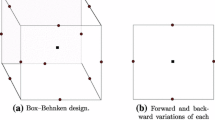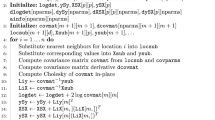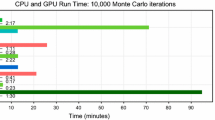Abstract
The surrogate modelling technique known as Kriging, and its various derivatives, requires an optimization process to effectively determine the model’s defining parameters. This optimization typically involves the maximisation of a likelihood function which requires the construction and inversion of a correlation matrix dependent on the selected modelling parameters. The construction of such models in high dimensions and with a large numbers of sample points can, therefore, be considerably expensive. Similarly, once such a model has been constructed the evaluation of the predictor, error and other related design and model improvement criteria can also be costly. The following paper investigates the potential for graphical processing units to be used to accelerate the evaluation of the Kriging likelihood, predictor and error functions. Five different Kriging formulations are considered including, ordinary, universal, non-stationary, gradient-enhanced and multi-fidelity Kriging. Other key contributions include the derivation of the adjoint of the likelihood function for a fully and partially gradient-enhanced Kriging model as well as the presentation of novel schemes to accelerate the likelihood optimization via a mixture of single and double precision calculations and by automatically selecting the best hardware to perform the evaluations on.





























Similar content being viewed by others
References
Akbariyeh A, Carrigan T, Dennis B, Chan W, Wang B, Lawrence K (2012) Application of gpu-based computing to large scale finite element analysis of three-dimensional structures. In: Proceedings of the 8th international conference on engineering computational technology
Angelikopoulos P, Papadimitriou C (2012) Bayesian uncertainty quantification and propagation in molecular dynamics simulations. In: ECCOMAS 2012—European congress on computational methods in applied sciences and engineering
Appleyard J, Drikakis D (2011) Higher-order cfd and interface tracking methods on highly-parallel mpi and gpu systems. Comput Fluids 46(1):101–105. doi:10.1016/j.compfluid.2010.10.019
Brandstetter A, Artusi A (2008) Radial basis function networks gpu-based implementation. IEEE Trans Neural Netw 19(12):2150–2154. doi:10.1109/TNN.2008.2003284
Brooks C, Forrester A, Keane A, Shahpar S (2011) Multi-fidelity design optimisation of a transonic compressor rotor. In: 9th European turbomachinery conference. Istanbul
Broyden C (1970) The convergence of a class of double-rank minimization algorithms. J Inst Math Appl 6(1):76–90
Challis V, Roberts A, Grotowski J (2014) High resolution topology optimization using graphics processing units (gpus). Struct Multidiscip Optim 49:315–325. doi:10.1007/s00158-013-0980-z
Cheng T (2013) Accelerating universal Kriging interpolation algorithm using cuda-enable gpu. Comput Geosci 54:178–183. doi:10.1016/j.cageo.2012.11.013
Cressie N (1993) Statistics for spatial data, probability and mathematical statistics. Wiley, New York
Czapinski M, Barnes S (2011) Tabu search with two approaches to parallel flowshop evaluation on cuda platform. J Parallel Distrib Comput 71(6):802–811. doi:10.1016/j.jpdc.2011.02.006
Demir I, Westermann R (2013) Progressive high-quality response surfaces for visually guided sensitivity analysis. Comput Graph Forum 32(3):2130. doi:10.1111/cgf.12089
Dwight R, Han Z (2009) Efficient uncertainty quantification using gradient-enhanced kriging. In: 50th AIAA/ASME/ASCE/AHS/ASC Structures, structural dynamics, and materials conference. doi: Y10.2514/6.2009-2276
Ferreiro AM, Garcfa JA, Lpez-Salas JG, Vzquez C (2013) An efficient implementation of parallel simulated annealing algorithm in gpus. J Glob Optim 57(3):863–890. doi:10.1007/s10898-012-9979-z
Forrester A, Bressloff N, Keane A (2006) Optimization using surrogate models and partially converged computational fluid dynamics simulations. Proc R Soc A 462(2071):2177–2204. doi:10.1098/rspa.2006.1679
Forrester A, Keane A (2009) Recent advances in surrogate-based optimization. Prog Aerosp Sci 45(1–3):50–79. doi:10.1016/j.paerosci.2008.11.001
Forrester A, Keane A, Bressloff N (2006) Design and analysis of “noisy” computer experiments. AIAA Journal 44(10):2331–2339
Forrester A, Sóbester A, Keane A (2008) Engineering design via surrogate modelling. Wiley, London
Fuentes M (2001) A high frequency Kriging approach for non-stationary environmental processes. Environmetrics 12:469–483
Gibbs M (1997) Bayesian Gaussian processes for regression and classficiation. Ph.D. Dissertation, University of Cambridge
Giles M (2008) Collected matrix derivative results for forward and reverse mode algorithmic differentiation. Lect Notes Comput Sci Eng 64:35–44. doi:10.1007/978-3-540-68942-3-4
Giles M, Pierce N (2000) An introduction to the adjoint approach to design. Flow Turbul Combust 65(3–4):393–415
Griewank A (2000) Evaluating derivatives: principles and techniques of algorithmic differentiation. SIAM, Philadelphia
Haas T (1990) Lognormal and moving window methods of estimating acid deposition. J Am Stat Assoc 85(412):950–963
Hofmann J, Limmer S, Fey D (2013) Performance investigations of genetic algorithms on graphics cards. Swarm Evol Comput 12:33–47. doi:10.1016/j.swevo.2013.04.003
Jameson A (1988) Aerodynamic design via control theory. J Sci Comput 3(3):233–260. doi:10.1007/BF01061285
Jia X, Gu X, Graves YJ, Folkerts M, Jiang S (2011) Gpu-based fast Monte Carlo simulation for radiotherapy dose calculation. Phys Med Biol 56(22):7017–7031. doi:10.1088/0031-9155/56/22/002
Jones D (2001) A taxonomy of global optimization methods based on response surfaces. J Glob Optim 21(4):345–383. doi:10.1023/A:1012771025575
Jones D, Schonlau M, Welch W (1998) Efficient global optimization of expensive black-box functions. J Glob Optim 13(4):455–492. doi:10.1023/A:1008306431147
Kampolis I, Trompoukis X, Asouti V, Giannakoglou K (2010) Cfd-based analysis and two-level aerodynamic optimization on graphics processing units. Comput Methods Appl Mech Eng 199(9–12):712–722. doi:10.1016/j.cma.2009.11.001
Keane A (2006) Statistical improvement criteria for use in mulitobjective design optimization. AIAA J 44(4):879–891
Kennedy M, O’Hagan A (2000) Predicting the output from a complex computer code when fast approximations are available. Biometrika 87(1):1–13. doi:10.1093/biomet/87.1.1
Krige D (1951) A statistical approach to some basic mine valuation problems on the witwatersrand. J Chem Metallurigical Min Eng Soc S Afr 52(6):119–139. doi:10.2307/3006914
Laurenceau J, Sagaut P (2008) Building efficient response surfaces of aerodynamic functions with Kriging and cokriging. AIAA J 46(2):498–507. doi:10.2514/1.32308
Leary S, Bhaskar A, Keane A (2004) Global approximation and optimisation using adjoint computational fluid dynamics codes. AIAA J 42(3):631–641
Leithead W, Zhang Y (2007) \(O(N^2)\)-operation approximation of covariance matrix inverse in gaussian process regression based on quasi-newton BFGS method. Commun Stat Simul Comput 36(2):367–380
Li Q, Salman R, Kecman V (2010) An intelligent system for accelerating parallel SVM classification problems on large datasets using GPU. In: Proceedings of the 2010 10th international conference on intelligent systems design and applications, pp 1131–1135. doi:10.1109/ISDA.2010.5687033
Liao Q, Wang J, Webster Y, Watson I (2009) Gpu accelerated support vector machines for mining high-throughput screening data. J Chem Inf Model 49(12):2718–2725
Lophaven S, Nielsen H, Søndergaard J (2002) Dace: A matlab Kriging toolbox, imm-tr-2002-12. Tech. rep., Informatics and Mathematical Modelling, Technical University of Denmark
Luo Z, Liu H (2005) Artificial neural network computation on graphic process unit. In: Proceedings of the international joint conference on neural networks. doi:10.1109/IJCNN.2005.1555903
Mishra V, Suresh K (2011) GPU-friendly preconditioners for efficient 3-d finite element analysis of thin structures. In: Proceedings of the ASME 2011 international design engineering technical conferences and computers and information in engineering conference
Paciorek C, Schervish M (2004) Nonstationary covariance functions for Gaussian process regression. Adv Neural Inf Process Syst 16:273–280
Pintore A, Holmes C (2004) Spatially adaptive non-stationary covariance functions via spatially adaptive spectra. Technical Report, University of Oxford, U.K
Gutiérrez de Ravé E, Jiménez-Hornero F, Ariza-Villaverde A, Gómez-Lpez J (2014) Using general-purpose computing on graphics processing units (GPGPU) to accelerate the ordinary Kriging algorithm. Comput Geosci 64:1–6. doi:10.1016/j.cageo.2012.11.013
Rumpfkeil M (2013) Optimization under uncertainty using gradients, hessians and surrogate models. AIAA J 51(2):444–451. doi:10.2514/1.J051847
Rupesh S, Deb K (2013) An evolutionary based bayesian design optimization approach under incomplete information. Eng Optim 45(2). doi:10.1080/0305215X.2012.661730
Sacks J, Welch W, Mitchell T, Wynn H (1989) Design and analysis of computer experiments. Stat Sci 4(4):409–435. doi:10.2307/2245858
Sampson P, Guttorp P (1992) Nonparametric estimation of nonstationary spatial covariance structure. J Am Stat Assoc 87(417):108–119
Sankaran R, Grout R (2012) Accelerating the computation of detailed chemical reaction kinetics for simulating combustion of complex fuels. In: 50th AIAA aerospace sciences meeting including the new horizons forum and aerospace exposition. doi:Y10.2514/6.2012-720
Simpson T, Peplinski J, Kock P, Allen J (2001) Metamodels for computer-based engineering design: survey and recommendations. Eng Comput 17(2):129–150. doi:10.1007/PL00007198
Toal D, Bressloff N, Keane A (2008) Kriging hyperparameter tuning strategies. AIAA J 46(5):1240–1252. doi:10.2514/1.34822
Toal D, Bressloff N, Keane A, Holden C (2011) The development of a hybridized particle swarm for Kriging hyperparameter tuning. Eng Optim. doi:10.1080/0305215X.2010.508524. (Accepted for Publication)
Toal D, Forrester A, Bressloff N, Keane A, Holden C (2009) An adjoint for likelihood maximization. Proc R Soc A 465(2111):3267–3287. doi:10.1098/rspa.2009.0096
Toal D, Keane A (2011) Efficient multi-point aerodynamic design optimization via co-Kriging. J Aircr 48(5):1685–1695. doi:10.2514/1.C031342
Toal D, Keane A (2011) Non-stationary Kriging for design optimization. Eng Optim. doi:10.1080/0305215X.2011.607816
Uchida A, Ito Y, Nakano K (2013) Accelerating ant colony optimisation for the travelling salesman problem on the GPU. Int J Parallel Emergent Distrib Syst. doi:10.1080/17445760.2013.842568
Viana F, Simpson T, Balabanov V, Toropov V (2014) Metamodeling in multidisciplinary design optimization: how far have we come. AIAA J. doi:10.2514/1.J052375
Voutchkov I, Keane A, Fox R (2006) Robust structural design of a simplified jet engine model using multiobjective optimization. In: 11th AIAA/ISSMO Multidisciplinary analysis and optimization conference. Portsmouth
Wachowiak M, Lambe Foster AE (2012) GPU-based asynchronous global optimization with particle swarm. In: High performance computing symposium 2012
Wang G, Shan S (2007) Review of metamodeling techniques in support of engineering design optimization. ASME J Mech Des 129:370–380. doi:10.1115/1.2429697
Xiong Y, Chen W, Apley D, Ding X (2007) A non-stationary covariance-based Kriging method for metamodelling in engineering design. Int J Numer Methods Eng 71(6):733–756
Zbierski M (2011) A simulated annealing algorithm for GPU clusters. In: 9th International conference on parallel processing and applied mathematics
Zegard T, Paulino G (2013) Toward GPU accelerated topology optimization on unstructured meshes. Struct Multidiscip Optim 48:473–485. doi:10.1007/s00158-013-0920-y
Zhang Y, Leithead W (2005) Exploiting hessian matrix and trust-region algorithm in hyperparameters estimation of Gaussian process. Appl Math Comput 171(2):1264–1281
Zhongwen L, Hongzhi L, Zhengping Y, Xincai W (2005) Self-organizing maps computing on graphic process unit. In: Proceedings—13th European symposium on artificial neural networks
Acknowledgments
The support of Rolls-Royce in carrying out this work is greatly appreciated.
Author information
Authors and Affiliations
Corresponding author
Rights and permissions
About this article
Cite this article
Toal, D.J.J. A study into the potential of GPUs for the efficient construction and evaluation of Kriging models. Engineering with Computers 32, 377–404 (2016). https://doi.org/10.1007/s00366-015-0421-2
Received:
Accepted:
Published:
Issue Date:
DOI: https://doi.org/10.1007/s00366-015-0421-2




